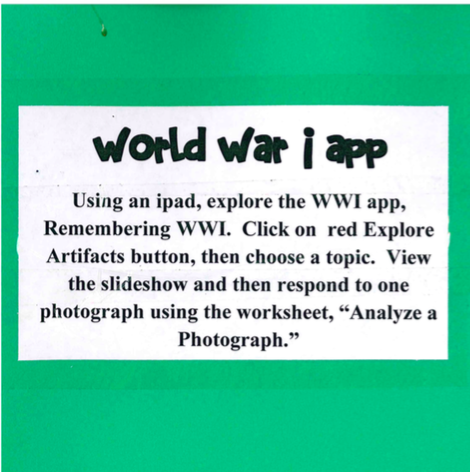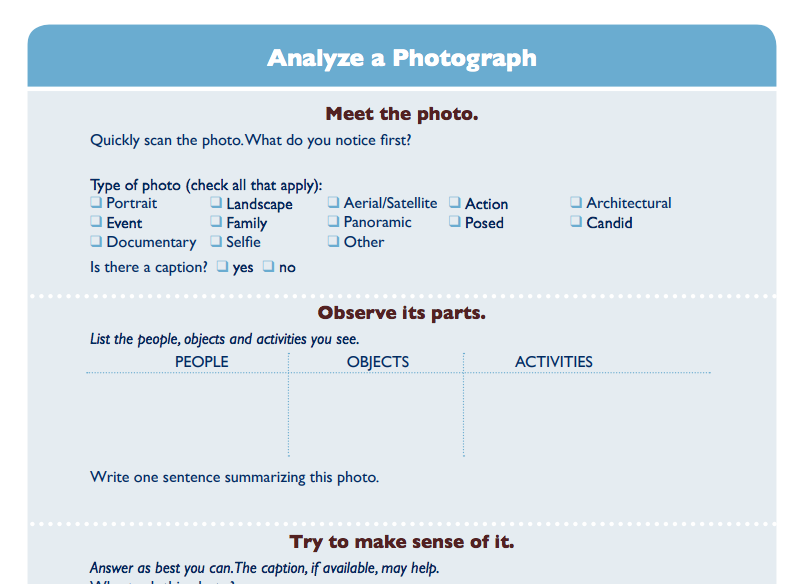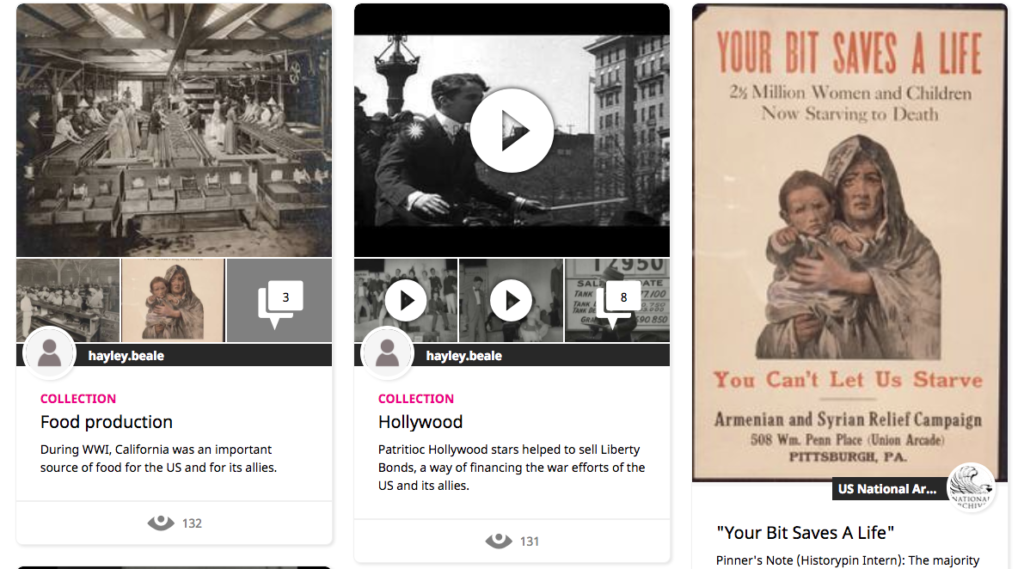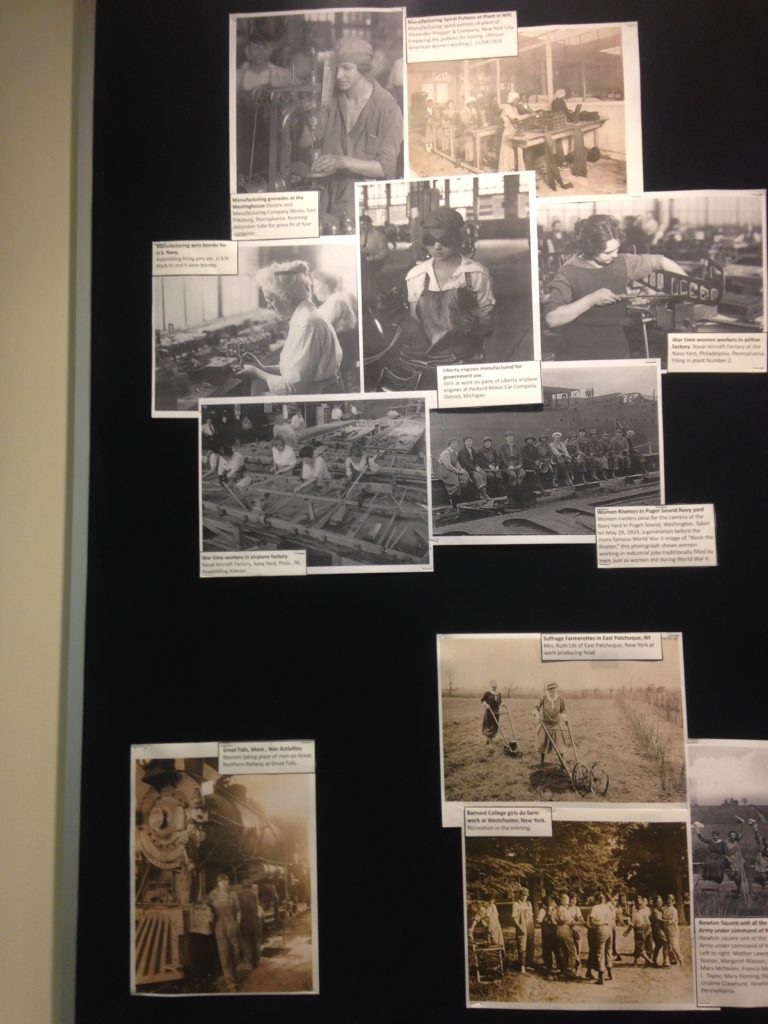Throughout the development of the Remembering WWI project, the US National Archives and Records Administration (NARA) has continuously been at the forefront of new user-design strategies, inviting teachers to provide the input that insures that this particular audience can easily reuse the app and its primary sources.
Below are some ready-to-go strategies for helping your students work with the vast collection of newly digitized WWI-era primary sources featured in Remembering WWI, helping them to make sense of the stories, events, and ideas of the past through document analysis and inquiry-based learning.
Pairing with document analysis worksheets
If you want to ease your students into working with primary sources, start with NARA’s DocsTeach document analysis worksheets. These downloadable forms will help your students think through the app’s featured WWI-era films and photographs for contextual understanding and to extract information to make informed judgments.
Below, 5th and 6th grade teacher Carol Huneycutt from Fayetteville, Arkansas created a simple prompt to pair with NARA’s “Analyze a photograph” worksheet:


As Carol did above, you may choose to let students explore WWI featured topics and documents of their choosing, or you can walk through one film or photo together with them.
Download the “Analyze a Photograph” worksheet from DocsTeach.
Download the “Analyze a Video” worksheet from DocsTeach.
Answering a unit-focused question – examples from a teacher workshop at UC Berkeley

On October 20th, teachers gathered at UC Berkeley for a Remembering WWI workshop, in partnership with the Berkeley History and Social Science Project (UCBHSSP). Very much in line with NARA’s Primarily Teaching strategies, teachers in this workshop researched WWI-era films and photos in the app that aligned with a specific unit-focused question or theme, and produced learning activities that would help incorporate these digitized sources into the classroom.
UCBHSSP is working on creating educator resources for California’s newly-adopted History and Social Science Framework, which emphasizes inquiry-based learning. To get students to think historically, we helped participants meditate on the experience between student and archive, and how to work from a treasure trove of sources in the app to help students interpret significance through evidence.
Guideposts for Historical Thinking
To think historically, students need to be able to:
- Establish historical significance
- Use primary source evidence
- Identify continuity and change
- Analyze cause and consequence
- Take historical perspectives, and
- Understand the ethical dimension of historical interpretations.
See a full list and explanation of these guideposts here.
To think about: Does one of the Guideposts speak in particular to the lesson question you’re focusing on?
Lesson Documentation examples from the workshop
Below are two sample lesson plans produced by educators at the workshop. Read more about what a Framework-aligned History Classroom looks like here.
Example lesson plan: Galvanizing support at home for the War
Who: Jennifer Collier, US History high school teacher
Lesson Focus Question: How did World War I change the identity of the United States from an isolationist nation to a global power?
Unit focus Question: How did the United State Government galvanize support at home for the Great War?
Pre-created collections for students to explore on: Remembering WWI app
Lesson documentation: here
Like Carol in the previous section, Jennifer also paired her lesson with a document analysis worksheet, provided by the UCBHSSP. Download the document here.
Example lesson plan: WWI Propaganda
Who: Jarred Fobian, High school history teacher
Unit Focus Question: Which was the most significant cause of WWI: Militarism, Alliances, Imperialism or Nationalism?
Lesson focus Question: How were elements of nationalism used in propaganda to gain public support of The Great War?
Pre-created collections for students to explore on: Remembering WWI on Historypin
Lesson documentation: here

Example lesson plan: California and WWI
Who: Hayley Beale, School librarian
Lesson Focus Question: What was California’s role in WWI and what was the lasting significance of this nationally?
Unit focus Question: How did the United State Government galvanize support at home for the Great War?
Pre-created collections for students to explore on: Remembering WWI on Historypin
Lesson documentation: here

Some images of Hayley’s the amazing WWI bulletin board she created within her school, reusing images from Remembering WWI:


To create WWI collections on Historypin as Hayley did (if you don’t have access to tablets in the classroom for example), see this step-by-step guide.
More things to note about NARA’s WWI sources
In exploring these guideposts in the workshop, here are some things of note to discuss with your students about NARA’s WWI-era sources:
- An important part of the sources is that they are revealing. That is, they shed light on enduring or emerging issues in history or contemporary life.
- There are two types of sources to talk about with students: 1. The visual source itself 2. Interpretive caption of it
- What makes these sources particular? 1. Gov-produced, staged 2. Early war journalism
An important thing to note is that any of these lesson plans and above questions can be applied to working with primary sources beyond this conflict, such as World War II.
Historypin teamed up with the US National Archives (NARA) to develop the Remembering WWI tablet app, part of the Wartime Films Project. You can learn more about the national collaborative Remembering WWI project here.
This project was made possible in part by the National Archives Foundation and a generous gift from an anonymous donor.
